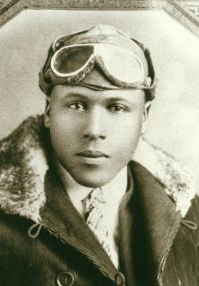James Herman Banning, known as “Herman,” was born on 5 November 1899, in Canton, Oklahoma Territory, the last of four children born to Riley W. Banning, a farmer, and his wife Cora Woods Banning. After moving to Ames in 1919 to attend ISC, he studied Electrical Engineering. Like many of his Black college classmates, Banning worked while attending school and after leaving ISC in 1924 to pursue his dream of becoming a pilot; he operated the J. H. Banning Auto Repair Shop from 1922 to 1928. After catching the flying “bug” in 1920, Banning took flying lessons in Des Moines. He became “the first Black aviator to receive a federal pilot’s license and the first Black pilot to complete a transcontinental flight across the U.S.” (Ames History Museum).
During his time in college, Banning also lived for a number of semesters in what residents called “The Interstate Club,” an apartment at 226 1/2 Main Street in the Elliott Building. While living there, he met fellow Interstate Club resident Frederick D. Patterson (D.V.M. 1923, M.S. 1927). Patterson later wrote about seeing Banning fly when he lived in Iowa, the first time Patterson had seen a Black aviator. This inspiration, along with the likes of Black Aviator Bessie Coleman and others, encouraged Patterson to see the potential for a commercial aviation program at Tuskegee Institute (now Tuskegee University), where he became president in 1935. This was the program that produced the famed Tuskegee Airmen of WWII.
Banning left Iowa in 1929 to take a job in Los Angeles, CA, teaching other African American would-be pilots as chief instructor at the newly opened Bessie Coleman Aero Club aviation school. While there he also purchased his biplane, christened “Miss Ames.” A few years later, from 18 September to 9 October 1932, Banning and co-pilot Thomas Cox Allen, completed a coast-to-coast flight from Los Angeles to New York City that secured for these so-called “Flying Hobos” the distinction of being the first African Americans to complete a transcontinental flight. (Moore).
Only a few months later, on 5 February 1933, Banning died in an air crash (aged 33), during an air show in San Diego, CA. As the biography of Banning on the Oklahoma Historical Society website notes, “Because of his color, this experienced pilot was not allowed to fly the plane in the air show. Instead, he had been only a passenger in a plane piloted by an aviation machinist mate second class from the San Diego Naval Air Station” (Moore). Banning is buried in Evergreen Cemetery, Los Angeles, CA.
In fall 2022, the Ames City Council renamed the Ames Municipal Airport the James Herman Banning Ames Municipal Airport in recognition of Banning’s contributions to aviation history and his ties to the Ames community.
Photo courtesy of Philip Hart, University of Massachusetts, Farwell T. Brown Photographic Archive, Ames Public Library.
Sources
Ames History Museum. “Know History. Build a Better Future,” Ames History Museum, https://ameshistory.org/content/know-history-build-better-future.
Moore, Bill. “Banning, James Herman,” The Encyclopedia of Oklahoma History and Culture, https://www.okhistory.org/publications/enc/entry.php?entry=BA042.
